#LM-1 Linn Drum Machine
Text
"(Prince) was very important to my success. He didn’t just select a stock beat and press ‘play,’ but rather used it in unusual and creative ways, from detuning the drums to no longer sound like drums to the unusual beats he programmed to how he featured it in the mix."
0 notes
Text
213341 Art Studio IIIA ⋆ Week 7 - It's Like Breathing

If you’ve heard David Bowie’s Space Oddity, then you’ve probably heard the Mellotron. A beefy keyboard running a tape loop, it was expensive, but cheaper than a string section. It was also what we would later call a sampler.

Tape degrades with time, however. Digital doesn’t, and electronic engineer Roger Linn addressed this with his LinnDrum, introduced in 1980 as the LM-1. Unlike previous drum machines, Linn’s used a chip, sampling acoustic drums rather than generating synthetic ‘clicks’.

A year later, E-mu systems would come through with the Emulator, a sampling keyboard that worked - with a 128kb capacity - off a floppy disk that the artist themselves would supply. While swapping the sample 'source’ was possible in previous samplers, to be able to record onto a floppy disc was cheaper, more accessible - and you didn’t have to rewire the damn thing to do it!
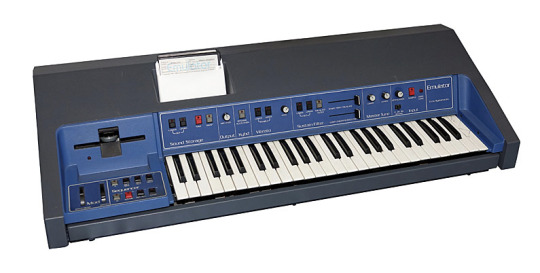
In 1984, AKAI would bring Roger Linn’s expertise along for the S612, a rack-mounted sampler designed to be connected with a MIDI keyboard.
MIDI, or Musical Instrument Digital Interface, had been introduced some years prior as a standardised 'language’ between different makes of synthesiser, and saw the creation of MIDI instruments - that don’t synthesise sounds themselves, but rather trigger sounds on a MIDI-connected device.

MIDI is in just about any digital instrument worth its salt nowadays.
Collaborating on the production of Death Grips’ avant-garde 2014 album N[____]s on The Moon, Bjork provided the band with a number of her vocal samples, with which the drummer, Zach Hill, connected, via MIDI, to different pads on his electronic drum set.
The second half of Big Dipper features a solo entirely made out of MIDI Bjork noises. It’s beautiful.
youtube
In 1988, the modern sampler was born. The Akai MPC60 is what was called a groovebox - an all-in-one workstation designed for affordable, accessible use. Samples could be loaded on, edited, and assigned to big juicy pads for replaying. The whole thing was portable too; the people’s sampler.
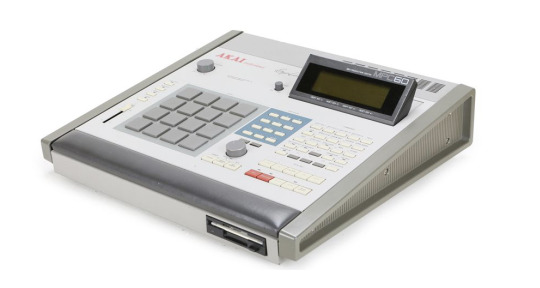
Four years later, a struggling artist that we now know as DJ Shadow saved up his money and brought one.
Mastering his craft, DJ Shadow released his debut album Endtroducing in 1996, a culmination of two years of entirely sample-based composing; minimally produced on the MPC60, a turntable, and an eight-track tape recorder. It’s straightforward.
Oh, but it pays off. With front-to-back trip-hop instrumentals, DJ Shadow put the beats to the forefront, the samples the main attraction. Hours a day, spent at the record store, listened to over and over for the perfect little snipped, every sample raising its voice, stating its case, and leaving politely.
One of my favorite examples of this is on Organ Donor, where an organ sample of a descending scale is transformed into a groovy solo. Listening closer, every note from the sampled organ has been assigned and re-arranged on the sampler. Y'know, he could’ve just brought a keyboard, but he didn’t.
youtube
Presentation week! Chasing down Mike at last, we got to talking as to the audio side of Em and I's dual presentation.

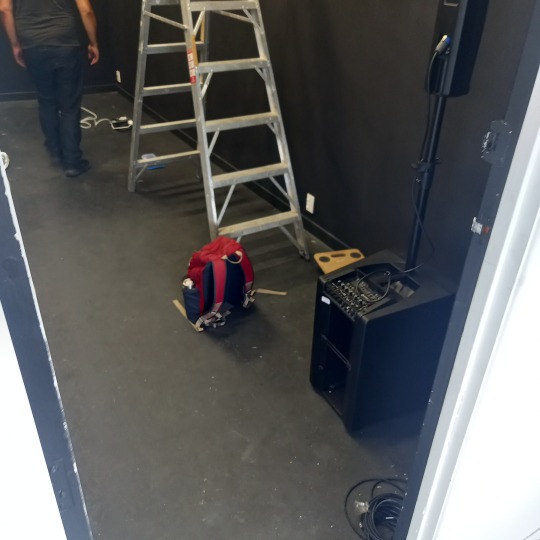
A projector was already set up, but speakers still needed to be brought in. He let me borrow a pocket MP3 drive to load my track onto, which would then connect via Bluetooth to the speakers. Meeting two days later, and bringing in the speakers, we had a little tech test, and things were working well.


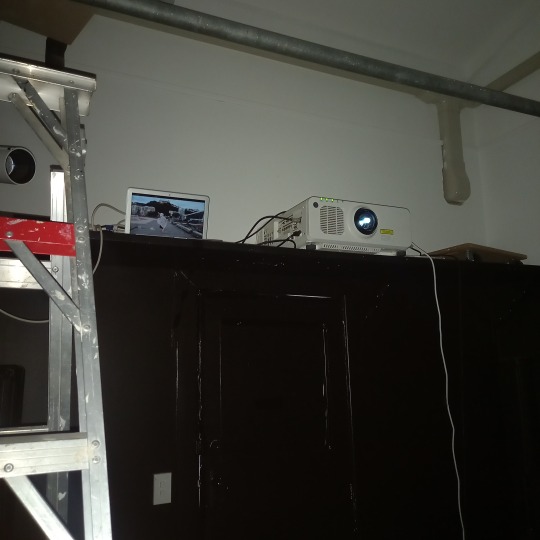
On the day of critique, I came in 10 minutes before class, set up the tech, and all was good! It feels nice to have things go right.
CRITIQUE TIME, BABY.

Aside from some hiccups with the projector, presentation went just as planned. The speakers were fantastic, and as the critique group walked in for viewing, neither our pieces were beginning or ending.
Following a full four-minute cycle of my song, they had this to say:
The audio achieved a calming atmosphere, at points nostalgic, and even descending into an eerie distortion; flowing in forward, circular motion that neither ended nor began. The ambience created by this soundscape would likely work well with most visuals, remaining ‘level’ in its tonality throughout.
While both pieces were made separate to one another, the two pieces sync to the degree that they appear inseparable, to which the experience would differ without one another.
In watching, the mind yearns for a narrative, as Em’s hopping, dancing motions appear to respond to the music. Fabric bellowed and swayed like butterfly wings, evoking the emotions towards the slow, comfortable sounds that came and went in forward progression; that moved in ‘one direction’ that reflected the forward motions of the video.
Although sonically enjoyable, it doesn’t come across as a work of plunderphonics. The sound palette and smooth transitions progressed with too little markings of its choppy creation process, looping not as the focus, but as the accompaniment to Em’s video.
Over-polishing seems to be the issue behind these issues of distinction– if I wanted to better convey the actions of sampling, there could always be a more jarring variety of sounds present; even drawing from non-music samples – and still striking that balance of audible creation and visual representation.
0 notes
Text
Electronic Instruments
Drum Machines
https://www.youtube.com/watch?v=u6Hep6WlWfY
Written by drummer, Roger Taylor, Radio Gaga by Queen uses the LinnDrum drum machine (Linn LM-1) as well as a number of other electronic instruments.
Synthesizers
https://www.youtube.com/watch?v=_6FBfAQ-NDE
Out of Depeche Mode’s four band members, three contributed to the iconic synthesizer sounds in Just Can’t Get Enough. Martin Gore used the Yamaha CS-5 synthesizer, Vince Clarke used the Kawai 100F and Roland Jupiter-4 synthesizers, and Andy Fletcher used the Moog Prodigy synthesizer. Together, the synthesizers used create an upbeat and funky sound.
0 notes
Text
A-T-3 125 Run DMC - Sucker MC's
Sucker Mc's is the b-side of Run DMC's debut single and a pivotal record in hip hop. The most common line is 'it ushered in a new era of hip hop,' 'pioneering the new-school' and kick starting 'the drum machine era' (1983-1986) with its stripped down sound. It's been said to have introduced 'real hip hop' to audiences, 'saving hip hop from going stale' or becoming a passing fad. Fresh is the word and Run DMC were the first hip hop group to go platinum in the US, so the group themselves are also a marker for hip hop's commercial success. Being held in such high regard Sucker MC's has had its story told many times, but the first telling of how Sucker MCs came about are in the lyrics themselves
“Took a test to become an MC" - Run had been DJ for Kurtis Blow who was managed by his brother Russell Simmonds
"and Orange Krush became amazed at me" - Orange Krush was Kurtis Blow's backing band which included Larry Smith, Trevor Gale and Davy DMX
"So, Larry put me inside his Cadillac, the chauffeur drove off, and we never came back" At this point in the lyrics it's just Run, Russell Simmonds originally wished for his brother Run The MC to be a solo artist. Larry its Larry Smith of Orange Krush who, as well as working with Kurtis Blow and Run DMC, worked with Jimmy Spicer, "Love Bug" Starski, Dr Jeckyll And Mr Hyde, Starchild in those early years, and Whodini from 1984 - there's not enough said about Larry Smith
"Dave cut the record down to the bone, and now they got me rocking on the microphone” In 1982 Orange Krush released a disco track called Action. The beats for Sucker MC's is Trevor Gale's drum pattern from Action replayed on a Oberheim DMX drum machine. In the lyric this is Dave (Davey DMX) that cuts the record down to the bone. It's literally (Orange) Krush's groove
Run DMC are Joseph Simmons (Run), Darryl McDaniels(DMC), and Jason Mizell (Jam Master Jay)
Sucker MC's is said to take hip hop (meaning rap) back to its origin of 'rapping over a beat.' like you hear on Spoonie Gee's seminal track Love Rap from 1980. "Run-D.M.C's debut marked the start of a new era that saw a return to hip hop's roots in breakbeats, sampling and drum machines." What we have to take into consideration here is drum machines are still new and very expensive, the Oberheim DMX drum machine was released in 1980 and would have cost over $10,000 in todays money. I maybe wrong but I'm guessing when talking about going back to it's roots of 'rapping to a beat' that was more often than not that was a loop of a recorded live drum rather than a drum machine. The Oberheim DMX was released shortly after the Linn LM-1 in 1980, but the more popular LinnDrum didn't come out until 1982. The Roland TR-808 also came out in 1980 and was replaced by the TR-909 in 1983
"The mainstream was not quite prepared for the concept of breakbeats." - I'm getting these quotes from this awful article. In 1982 Malcolm McLaren releases Buffalo Gals, in 1982 in peaked at number 9 on the UK singles charts, and sold well around the world. Of course it's a bit of a novelty record but it also features an Oberheim DMX with a pretty sparse arrangement and was very influential
Run DMC's set up of emcee and a dj would become the new template of a rap group, although the dj would often get pushed out of the limelight. I don't agree with this statement "no major record label was willing to bet on a DJ over a live band." I've mentioned Buffalo Galls, that is The World's Famous Supreme Team djs scratching over the DMX drum beat and Trevor Horn el embellishing with a few samples from their new Fairlight CMI (is it the first hip hop record you use actual samples?), Grandmaster Flash had released the breakthrough dj record The Adventures Of Grandmaster Flash On The Wheels Of Steel in 1981, Grandmaster D.St is releasing records in 1982 and introduces mainstream US audiences to scratching in 1983 when he plays on Herbie Hancock's Rockit (most notably when he steals the show at the 1984 Grammy's). Then there is Planet Rock, Afrika Bambaataa and Arthur Baker are both dj's and recording in the dj come producer/remixer tradition of the disco era
I've seen Sucker MC's drum beat described as a sample and held up as introducing sampling to hip hop, "sampling was more stigmatised at the time." First of all it's not a sample is it, only if you want to call the sounds of the DMX samples, which would be technically right, but it's not sampling like you hear on Buffalo Gals. The reason sampling wasn't common in hip hop at the time is because samplers were rare and ridiculously expensive
Run DMC - Sucker MC's so good
youtube
The Beastie Boys performing Sucker MC's (5m18s) at the fist VH-1 Hip Hop Honours, which in my opinion was better than the Grammy's Hip Hop 50 celebration
youtube
1 note
·
View note
Text
What is Music Technology?
For those of you who are not familiar with the terminology, music technology refers to the devices used to create and play music. It includes instruments such as drums, synthesizers, samplers and sequencing machines. There are many different types of devices available, but some of the more popular and most widely used include those made by Moog.
Synthesizers
Synthesizers are devices used to create electronic sounds, enabling musicians to compose music. They can also be used to create soundscapes and music for live performances. Some synthesizers are analog, while others are digital. A synthesizer is used to control volume, intensity, and frequency of a sound.
In addition, a music synthesizer can alter the wave forms of an instrument, producing a distinctive timbre and pitch. Mixing component sounds can also give an instrument a unique sound.
The first synthesizers were experimental special-built devices. They were built in the early twentieth century by Raymond Scott, Don Buchla, and Hugh Le Caine. These devices were often configured using modularity.
Samplers
Samplers are an important tool in the music industry. They help artists insert themselves into the narrative. A sample can be any type of recorded audio. Some examples include film dialogue, streetcar noise, rain hitting pavement, or even a snippet of a song that was previously played. Using a sample allows musicians to save time and money by recording only what they need, and it also allows them to create their own beats.
Sampling has been around for a long time. Hip-Hop was the first genre to take advantage of this technology. Initially, samplers were expensive and difficult to use. However, as technology advanced, they became easier to use and cheaper to maintain.
Drum machines
A drum machine is an electronic device used to create percussion sounds. They typically have multiple modes, including a song mode, clave, waltz, and tempo adjustments. Most drum machines have built-in effects and can generate patterns in real time.
One of the first programmable devices was the Roland TR-808, which became popular in hip hop music. Its features included a high-end sequencer, and the ability to create your own rhythms.
Another innovative programmable device was the Rhythmicon, developed by Russian inventor Leon Theremin. This was the first programmable drum machine, incorporating multiple wavelengths into beats.
The Eko ComputeRhythm, meanwhile, was the first programmable drum machine with touchscreen controls. The LM-1 Drum Computer, developed by Linn, was also a milestone in the world of digital samples.
Sequencers
Sequencers are rhythmic tools used to program and create melodies, articulations, and effects. They're usually found in a hardware or software form. These may include a piano roll, step sequencer, or even a sequencer that's built into a DAW.
In the early days of music technology, sequencers were often played by hand. However, today, many are programmed. This frees up the hands of the performer to play and manipulate the sound. Using a sequencer can also save time. By programming notes in advance, a performer can play back a musical performance in a different order.
A sequencer's output is huge. Often, it's a "warmed-up" version of the output of a synthesizer. This allows for the production of interesting polyrhythms.
Side chaining
Side chaining is an audio processing effect that involves routing the output from one track to control the level of another. Typically, this is done by using a dynamics processor such as a compressor or an expander. It is a common technique that can be used to enhance the performance of a number of different instruments. The process allows you to keep the lead guitar at the forefront of your mix while minimizing unwanted ambient noises.
While side chaining can be a very powerful tool, it is also a very delicate procedure. It can lead to a muddy mix if not done correctly.
Moog Modular systems
The Moog Modular is a tabletop synthesizer created in 1968 by Wendy Carlos. It's used by artists like Stevie Wonder and Brian Eno.
These synthesizers are very popular as collectors' items. Even small ones can sell for huge sums of money. If you are interested in owning one, you can buy them on the second hand market. But you need to be prepared to do some work.
Unlike modern digital synthesizers, Moog modular systems aren't as easy to use. You need to write down the settings and connections on each module. And they lack safety features and software interfaces. They're also expensive to purchase.
0 notes
Text
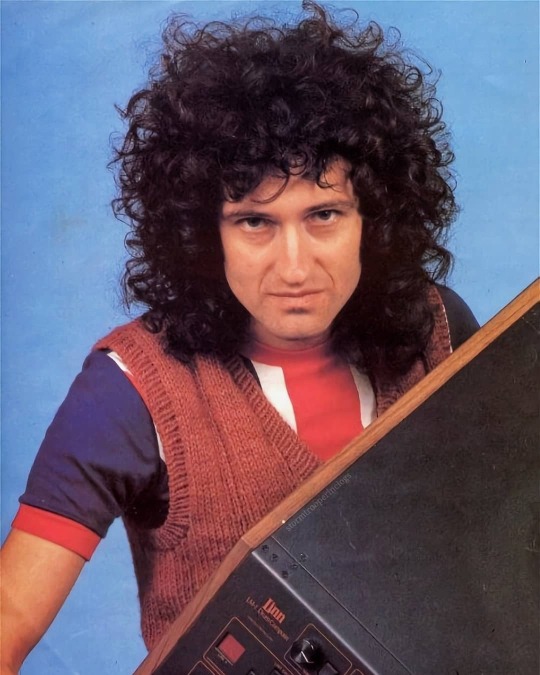
Brian with a Linn LM-1 Drum Machine, 1981.
(×)
14 notes
·
View notes
Video
youtube
Buy here!
#Bassmobile#Alesis#hr16#16bit#Drum Machine#Oberheim DX#Oberheim DMX#Sequential Circuits#Drumtraks#Linn Drum#LM-1
2 notes
·
View notes
Photo


Heaven 17 - (We Don't Need This) Fascist Groove Thang (1981)
Martyn Ware / Ian Craig Marsh / Glenn Gregory
from: "Penthouse and Pavement" LP
Synth-Pop | New Wave | Electropop
JukehostUK
(left click = play)
(320kbps)
Personnel:
Glenn Gregory: Lead Vocals
Ian Craig Marsh: Synthesizers
Martyn Ware: Synthesizers / Linn LM-1 (Drum Machine) / Backing Vocals
Malcolm Veale: Synthesizers
Josie James: Backing Vocals
John Wilson: Bass / Rhythm Guitar
Produced by British Electric Foundation
(Martyn Ware / Ian Craig Marsh)
Recorded:
@ Maison Rouge
in Sheffield, England UK
Single Released on March 6, 1981
Album Released in September of 1981
#Heaven 17#(We Don't Need This) Fascist Groove Thang#Synth-Pop#Fascist Groove Thang#1980's#Martyn Ware#Ian Craig Marsh#Glenn Gregory#British Electric Foundation#B.E.F.#Virgin Records
4 notes
·
View notes
Photo

777 9311 Hours of Work – Restoring the First Digital Drum Machine
I’ve always been a huge fan of Prince. His trademark sound owes a lot to the Linn LM-1, the first digital drum machine ever, designed by Roger Linn in California in 1979. Only around 500 were made and Prince actually had three of them at Paisley Park studios. Here’s the story of my #315 made in 1981.
I never expected to find a LM-1 for sale ever. Despite its scarcity in early 2009 I tracked down a LM-1 on a second-hand music gear website in Germany. The seller confessed it had for years served as a cellar door stopper in a Swiss recording studio. It was serviced by Bruce Forat (a former Linn Electronics employee) in the US — who reportedly was not able not fix it 100 %. But we’ll come to that in a minute.
She Blinded Me With … Magahony
LM1 #315 looked amazing, quite impressive in size. Perfect layout, orange print on black powder coated steel, luxurious mahogany side panels. 12 glorious 8 bit samples at 28 khz plus analogue CEM 3320 filters for bassdrum and toms/congas.
The CEMs are adjustable internally via trim pots, which was only introduced on revision 2. As in revision 3 though, there was no external sync on this LM-1 originally and no clock rate switch in the back. But it had a low output jack which was supposably removed on revision 3. All that makes my LM-1 some kind of revision 2 and a half, technically. The clock input was retrofitted at some point in the past.
That’s it for the basics. The rest turned out to be pure esoterics.
I never figured out when or when not it would work. Sometime I had to turn it up 20 times, before it would run. On some occasions, it would just go berserk in the middle of a programming session, preferably while messing with complex rythms and before I saved it that pattern of course. Faders where performing poorly, too. And only recently I found out it was also sensitive to room temperature … and maybe the axial tilt of the earth?
All that called for a checkup pretty early in my ownerhsip, but who’d do it if even Bruce Forat had turned it down? And why would I keep that four decades old piece of early digital gear with little to no documentation at all?
The answer is simple: Nothing sounds like the LM-1!
Bring the Beat Back
I introduced Alex, a talented friend of mine with a masters degree in electronics, to the quirks and features of the LM-1, and then we started off restauration.
First, I got new faders from synthpatchers in Canada for a whopping 239 $. That’s a lot of money for a de facto 99 ¢ mouser.com fader. (The original faders are Mexico 112 1002 94, the same as used in ARP synths.) The only problem is to find out which of the thousands available fit into the LM-1, because the sockets are said to be different from the stock one, but I can’t verify that.
You either have to take the stock ARP ones and modify them, use other faders and built an adaptor yourself — or just go with the synthpatchers.com parts that will just work as designed (the original faders were performing very poorly so cleaning was no option either).

The faders arrived after four weeks and another whopping 80 € for shipping plus customs. Globalization doesn’t work for everyone …
According to the service sheets and schematics, the LM-1 power supply runs on 15 volts. Actually, it’s a 12 volt Power-One HTAA-16W power supply with a little “power boost” that did not provide equal current anymore. We were unsure how long the power supply would still work correctly after 40 years. Since it’s a crucial component and we wanted to avoid future consequences for the rest of the circuitry, instead of recapping it we simply replaced it with a modern switch power supply running stable on exactly 15 volts.

Those rechargeable batteries were also replaced along with a few rotten voice board capacitors (see white circle). Some display pins had also gone loose and were fitted back in.
It turned out the startup issue was a consequence of a glitch in the power supply and the display pins. When you switch on the LM-1, the OS boots within seconds and if that initial current is incorrect, it won’t boot at all.

More Light
This is a historic piece of gear, so any restoration is of course also a question of philosophy. Do you want a museum piece, maybe not working 100 %, but 100 % original? Or do you want to use it the way Roger Linn designed it — as a musical instrument, ready to perform? I decided on the latter.
Repairs aside, any non-reversable modification was not an option for me. But an easily removeable and musically justifiable mod – why not?
After Alex had figured everything out, the LM-1 worked perfectly. Since it’s a revision 2 with three unused holes covered by blank jacks in the back, we were going through possible reversable modifications to the circuitry and having them controlled with pots sitting in those unused holes.
We decided on a filter cut-off and resonance mod. One that allowed for both the bassdrum CEM and toms/congas CEM to be controlled from the back.
To achieve cut-off change one resistor had to be slightly decreased in value, so the internal trim pot would cover the entire filter range, not just half of it like in the factory setting (it was not intended to be changed as a “sound feature”). For resonance Alex soldered in two extra resistors. Then he took two pots with two dual caps as CV source and wired them to the filters (see photo below; new switch power supply also installed).

Finding a musically usefull range for resonance took a bit of fiddling. Due to a missing VCA, self oscillation did not make sense (you would just get a constanc hum) and also VCF envelope modification, though theoretically possible, was turned down due to irrelevant results (the samples are just too short).

It was important to me to have the factory VCF and resonance setting available at any time, because that’s the sound the LM-1 is famous for. The new dual pots are set in exactly that way: at 12 o’clock it’s the factory sound, to the left and right you can now either enhance or erase high frequencies and artefacts — for the VCF.
For resonance, the setting is slightly different, because resonance wasn’t used in the original design at all: for resonance amount zero (factory spec) the pot is turned far left. As you turn it up, resonance increases.
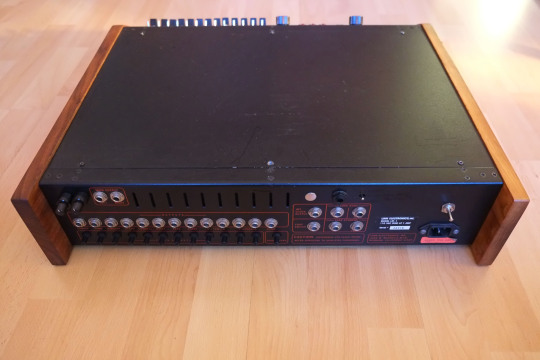
That’s it! A total nerd topic, but I hope someone will find this usefull because documentation, as I said in the beginning, is pretty rare on this machine.
I’ll leave you with the greatest LM-1 beat ever made:
youtube
#linndrum#lm-1#prince#linnlm1#autowahn#music#drummachine#80s#synths#roger linn#7779311#the time#7779311 challenge
40 notes
·
View notes
Photo

Roland TR-808
The Roland TR-808 Rhythm Composer, commonly known as the 808, is a drum machine manufactured by the Roland Corporation between 1980 and 1983. It was one of the first drum machines to allow users to program rhythms instead of using preset patterns. Unlike its nearest competitor at the time, the more expensive Linn LM-1, the 808 generates sounds using analog synthesis rather than playing samples.
Launched when electronic music had yet to become mainstream, the 808 received mixed reviews for its unrealistic drum sounds and was a commercial failure. After building approximately 12,000 units, Roland discontinued the 808 after its semiconductors became impossible to restock. It was succeeded by the TR-909 in 1983.
Over the course of the 1980s, the 808 attracted a cult following among underground musicians for its affordability on the used market, ease of use, and idiosyncratic sounds, particularly its deep, "booming" bass drum. It became a cornerstone of the emerging electronic, dance, and hip hop genres, popularized by early hits such as "Sexual Healing" by Marvin Gaye and "Planet Rock" by Afrika Bambaataa and the Soulsonic Force.
The 808 was eventually used on more hit records than any other drum machine. Its particular popularity in hip hop has made it one of the most influential inventions in popular music, comparable to the Fender Stratocaster's impact on rock. Its sounds are included with music software and modern drum machines, and it has inspired numerous clones.
2 notes
·
View notes
Photo

It’s #LPPSaturday and #BlackLivesMatter 🖤Let's celebrate the #Genius of #Prince and #TroyGua 'til the world stops spinning ~ Inspiration: Drum Pad Tech and Signature Sounds • Love this? Join the club - literally! Help power the project (AND GET BEHIND THE SCENES ACCESS and COOL STUFF!) by joining #ClubLPP 👉 patreon.com/clublpp • From the February 2019 moderndrummer.com interview with @bobbyz1999 : . 'Prince had one of the first Linn LM-1 drum machines. I think drum machines in general scared all drummers back then, but Prince’s manager at the time, Steve Fargnoli, gave me some advice. He said, “It’s here, so learn how to use it.” It was very good advice. At the onset there was no technology available to support Prince’s desire to have a drum machine that was playable via pads. We used the outputs from the LM-1 to trigger small acoustic guitar pickups and mics placed inside the snare. Don Batts, our genius tech, had created an interface that made Simmons pads trigger the Linn sounds. It was quite unpredictable but technology quickly caught up, and playable pads became popular. Prince’s real precision innovation in the studio was the Pearl Syncussion pads and sounds. On our tour now I use samples of those sounds to create the authentic electronic cymbals, toms, and bombs that are such a big part of our music.' • #Prince4ever #LePetitPrince #LPPisART #TroyGuaArt #Surrealism #Photography #Sculpture #StagedPhotography #OneSixthScale #Miniatures #PopArt #ArtImitatingLifeImitatingArt • 💜 x ∞ • ➡️ ➡️ ➡️ https://troygua.com/le-petit-prince https://www.instagram.com/p/CBYaVBmF093/?igshid=ptqo296poajy
#lppsaturday#blacklivesmatter#genius#prince#troygua#clublpp#prince4ever#lepetitprince#lppisart#troyguaart#surrealism#photography#sculpture#stagedphotography#onesixthscale#miniatures#popart#artimitatinglifeimitatingart
1 note
·
View note
Video
This track is influenced by 80s film and TV scores. All sounds are played by me using various VST instruments such as VLINN. (The Linn LM-1 is my favorite drum machine and the VLINN VST emulates it quite faithfully.) Visuals are from an early 80s Sony Betamax infomercial.
Composed & recorded by @jpegfantasy 🎵
#80s#1980s#aesthetic#aesthetics#retro#vintage#synth#synthpop#soundtrack#score#linn#linndrum#drum machine#synthesizer#sony#betamax#vhs#VCR#hifi#tech#retro tech#music#synth music#70s#1970s#film#tv#synthwave#electronics#stereo
261 notes
·
View notes
Text
Knight Rider The Fan Game Demo


Knight Rider The Fan Game Demo Game Download
Knight Rider Game Free Download
Knight Rider Games online, free
From Sep 1982 to Aug 1986, Universal Television aired Knight Rider, an action-based adventure starring David Hasselhoff as a field operative for the Foundation for Law and Government (FLAG), intent on helping the 'innocent, helpless, and powerless' against the criminal element. The real star of the show, however, was a futuristic-styled Pontiac Trans Am, the Knight Industries Two Thousand (KITT), featuring a talking computer. Netherlands-based developer Davilex Games resurrects the characters, cars, and action of the 1980s series, putting the player behind the wheel of KITT in Knight Rider: The Game.
Knight Rider Demo. Play through a portion of the game inspired by the 1980's TV sitcom, Knight Rider, from behind the wheel of the high-tech super car known as KITT. De delftse methode netherlands voor buitenlanders pdf. Fight against crime using the most technologically advanced car ever made, featuring: -Turbo Boost.Super Pursuit Mode. Knight Rider The Fan Game. 2,963 likes 60 talking about this. Jump behind the wheel of everyone's favorite 80's talking super car KITT! The Fan Game follows a fictional Season 5 of Knight Rider.
Knight Rider The Fan Game Demo Game Download
Three difficulty options (easy, normal, and hard) determine the damage tolerance, duration of parts, and level of opponent aggression in the 15-mission campaign covering ten unique tracks. The KITT super car comes equipped with various capabilities including turbo boost, ski mode, night vision, microwave jammers, scanning ability, and targeting functions. https://hypeblog580.tumblr.com/post/661529985240186880/vlinn-20-linn-lm-1-drum-machine. Fans of the television show will recognize featured characters and enemies, such as KITT's evil double KARR (Knight Automated Roving Robot), Devon Miles (head of FLAG), and Goliath, a high-tech truck built by nemesis Garth used for mayhem and destruction.

Knight Rider Game Free Download

Knight Rider Games online, free
People who downloaded Knight Rider: The Game have also downloaded:
Knight Rider 2: The Game, James Bond 007: Nightfire, Lord of the Rings, The: The Return of the King, Matrix, The: Path of Neo, Leisure Suit Larry: Magna Cum Laude, Marine Heavy Gunner: Vietnam, LEGO Star Wars II: The Original Trilogy, Mortal Kombat 4

0 notes
Video
youtube
In this video I give a demo of the stock sounds in the Oberheim DX before replacing the EPROMs in the machine with copies of the original sounds from the Linn LM-1 and LinnDrum drum machines.
I made a video of the DX many years ago and it has become very popular - but it has always bugged me that the original video did not demonstrate the original sounds of the DX so I have made sure to include them in this one!
0 notes
Text
Free Drum Sampler Vst Plugin

“SL Drums 2 is a free VST drum machine, which with a single panel in the purest style drum-pad lets you create be. Line of Legends. “BPB proudly presents Grooove BPB, a freeware drum sampler in VST2, VST3 and AU plugin formats for PC and Mac, c. Acid machine Be. Unfortunately, this free drum free plugin offers no option of resetting the knob perimeter. Download it here. Free VST Plugins User Guide. If you want an efficient workflow in music production, you need the right software. Additionally, you also need to know how to use free software correctly.
The drum machine changed music. There’s no getting around it.
Every DAW software these days comes with some sort of sampler or drum machine built right in. They’ve become a pillar of modern music production.
But picking a sound can be tough when you have infinite possibilities at your fingertips.
That’s why these drum VST plugins are so great. They impose some limitations to help you corral the creative juices a bit.
So here’s the 10 best free drum VST plugins for making your drums pop.
1. T.REX 606
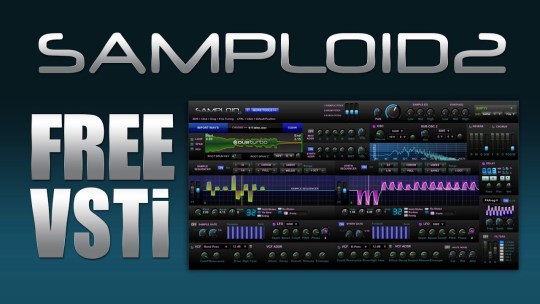

The name says it all. The T.REX 606 is a compact rompler modelled after the iconic Roland TR-606 drum machine.
The simple interface keeps things basic. Which is nice these days when so many VSTs are needlessly complicated.
It’s just volume, reverb and 7 classic sounds. Easy peasy.
Download it here for free
2. Djinndrum
The Linn LM-1 is a classic drum machine. It’s been used by everyone from Peter Gabriel, to Prince, to Michael Jackson.
Free Drum Sampler Vst
But let’s face it, these days they’ve gotten a bit pricey for what they are.
No problem, The Djinndrum has you set for all that classic sound that the LM-1 packs in.
Download it here for free
3. Drum PRO
Drum Pro has 20 built in drum kits, 12 pads and global effects, what more do you need from a drum machine plugin?
The Drum Pro has you covered no matter what you’re making. Big EDM? Check. Techno? Check. Everything else you need for sweet drums? Check that too.
Download it here for free
4. Line of Legends
Free Sampler Plugins
This plugin may not look as technical as others. But don’t let the looks of Line of Legends fool you.
This plugin boasts 47 high quality samples, 8 individual output channels, and punch, release & attack knobs for some serious tweakage.
Heads up: you may have to set up the output channels in your DAW if it’s only showing one channel. So check your DAW manual to figure out how.
Download it here for free
5. Sean Pandy Drums
Sean Pandy Drums is based on a sample pack made by heavy metal drummer Sean Pandy. So if you’re looking for a heavier drum sound on your mix, this VST will definitely give you it.
The ‘Sub Blower’ is especially good and certainly lives up to its name…
Download it here for free
6. KickMaker
2 of the most important elements in any track that thumps is the kick and bass. So they deserve some serious attention.
That’s what makes KickMaker so great. It’s a plugin built for crafting the perfect kick. So what’re you waiting for? Get kickin’.
Download it here for free
7. Beat Factory Drums
Beat Factory Drums is easy to use, sounds great, and packs a serious punch.
It has fully tweakable ADSR parameters so you can customize each and every kit to your sound. Not bad for a FREE plugin.
All you have to do is enter your email and that’s it.
Download it here for free
8. MT Power Drum Kit 2
MT Power Drum Kit 2 isn’t just a plugin for drums. In addition to top notch drum sounds that cut through any mix, it also has a fully pre-programmed groove library.
Free Vst Drum Downloads
It’s wicked for composing your own patterns, or stringing together grooves for the drum accompaniment you need.
Download it here for free
9. Dub Turbo DrumTROOP
The DrumTROOP drum machine is big both in its sound and what it offers. It’s a powerful tool for everything from EDM to house and back again.
Their website calls it a “weapon of mass production.” I can’t really disagree with that. It’s definitely massive is every respect.
Download it here for free
10. Single Cycle Vintage Drum Elements
Vintage Drum Elements has a nice, warm analogue sound that so many vintage drum machines have.
The 12 pad interface is easy to use and tweak, and the preloaded samples are all top notch.
Name your price or enter your email to grab it on the Single Cycle Bandcamp.
Download it here for free
Drumming up the perfect sound
Nothing beats a banging drum track. They’re the backbone of tons of top notch songs.
And the drum machine is a superb way to hone in on a specific sound for your tracks.
So grab these sweet plugs and program away!
Already set for drums? Grab some of our other favourite free VSTs.
Sometime you just need a plain good old sampler VST plugin for your tracks :
just load a .wav sample, tweak some envelope, maybe adjust pitch, and add some loop points. No more no less.
You don’t need the bells & whistles of Kontakt, nor gigabytes of library => just load some samples and come on !
https://coolobservationyouth.tumblr.com/post/640297816700354560/free-vst-pattern-sequencer. It comes with a special morphing feature that gives you the capabilities of up to 8 different programs in one.Monoplugs says its Monique a perfect instrument for jamming and live performances. Plus there are some built-in effects, also arpeggiator/sequencer. As for highlights, there’s special free filter routing, continuous morphable oscillators, advanced modulation and automation. See also:B-Step Sequencer is a step sequencer plugin and standalone application for creating melodic loops, chord progressions, arpeggios, drum grooves, and basslines.B-Step Sequencer comes with an array of features like chord programming, sequencer ratcheting, shuffle, drag-n-drop, copy, MIDI learn, and more. Monique free synthesizer.
So here’s a selection of 6 FREEWARE sampler in VST format:
1. TX16Wx VST
download 100% free : http://www.tx16wx.com/
Available for Windows (32 & 64 bit) & Mac (VST & AU 64 bit)
This one is more than a simple sampler for loading & playing audio files!
It’s the more complete & full featured free sampler.
Tons of modulations & envelope, powerful keyboard mapping…
You can choose between 4 sizes for the UI (from 800X600 to 1280X768)
and the plugin can record from its own inputs (DAW inputs).
This is also the more “up to date” plugin.
It can load wav, aiff ogg, flac + sf2 soundfonts and sfz.
Free Sampler Vst Plugin
2. Grace : Sampler
Grace Sampler
download : http://www.onesmallclue.com/plugin/grace/
Available for Windows in 32 & 64 bit VST format.
I find it more good looking than the TX16Wx!
It’s also very powerful; with keyboard mapping, envelope & modulation.
like the precedent, it can preview sounds, the browser is very nice.
can load wav, aif & snd + sfz bank sounds.
On the website you can also download library with good sounds.
3. ShortCircuit 2
Free Drum Kit Vst Plugins
download 4 free ! http://vemberaudio.se/shortcircuit.php
Availbable for Windows , 32 bit VST.
Sadly, Shortcircuit is discontinued.
But if you’re still using 32 bit VST, it’s one the best VST sampler around.
The Keyboard mapping (on a vertical view ! unlike the others), the modulation & evelope options, it’s very complete, and should work without any problems (you can also download older version if you experience some bugs)
can load wav files + AKAI sample file (AKAI S5000/S6000/ Z4 Z8) + sf2 files + Recycle REX files.
Drum Pad Sampler Vst Free
4. Paax 2 sampler
Paax 2 VST
direct download : http://www.behringerdownload.de/UCONTROL/p2_app.zip
A problem for some music creators is finding a decent sounding virtual guitar. https://coolobservationyouth.tumblr.com/post/640297827175710720/best-vst-guitar-plugins-2015. 10 Best: Guitars VST Plugin ReviewThe guitar is a standard instrument on many musical recordings.
Available for Windows 32 bit only VST.
Unfortunaly, the paax sampler has vanished from the internet, and is no longer developed.
The paax 3 was free for some time, and the paax 2 was always freeware.
The UI is small, but all the features are here.
Not the fastest workflow, but some like it like that.
5. EZ-Sampler
download : http://sbaudio.org/ez-sampler
Available for Windows, 32 bit VST only.
This one is simple, you can load only one sample, so no keyboard mapping.
Sometimes it’s just what you need ! and with EZ-Sampler, it’s fast and without troubles.
can load wav, aiff, ogg, flac, snd, wma & mp3 (need Lame Encoder).
6. Helios VST !
Tobybear Helios VST
dowload : http://www.tobybear.de/files.html
Available for Windows, 32 bit VST only.
From the Tobybear “insbag” VST collection. This one is old school !
ADSR on volume + filter + delay + LFO + loop. Just load a wav file and let’s go!
drop some LFO on the loop start : instant funkyness!

0 notes
Photo
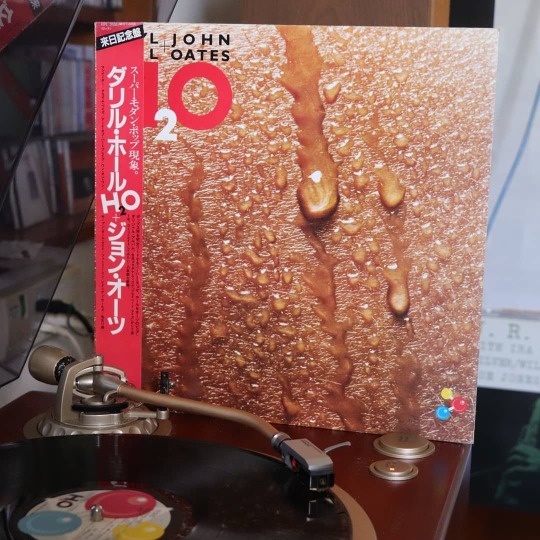
Daryl Hall + John Oates / H2O (1982) 梅雨明けた?暑い…汗が噴き出す。 写真2 何かに沿って伸びる。 写真3 伸びる。 #DarylHall – lead vocals, backing vocals, guitar, keyboards, synthesizers #JohnOates – backing vocals, lead vocals, 6 and 12-string guitars, electric piano, Roland CR-78 drum machine, Linn LM-1 G.E. Smith – lead guitar Tom "T-Bone" Wolk – bass guitar Mickey Curry – drums, percussion Charlie "Mr. Casual" DeChant – saxophone "Little Italy Mandolinos" – Daryl Hall, John Oates and Tom "T-Bone" Wolk Larry Fast – synthesizer programming Produced by Daryl Hall and John Oates #vinyl #vinylcollection #coverart #albumart #33rpm #lp #nowspinning #nowplaying #アナログ盤 #レコード #records #rock #soul #poprock #powerpop #RCARecords #1982 #宮古島 #coffee #コーヒー #cat #猫 (宮古島) https://www.instagram.com/p/CA_zwkUJjJ-/?igshid=ehfpq80w4gvt
#darylhall#johnoates#vinyl#vinylcollection#coverart#albumart#33rpm#lp#nowspinning#nowplaying#アナログ盤#レコード#records#rock#soul#poprock#powerpop#rcarecords#1982#宮古島#coffee#コーヒー#cat#猫
0 notes